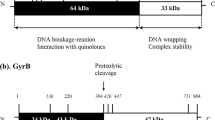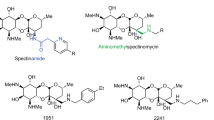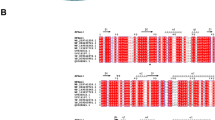Abstract
The antimicrobial activity of tumescenamide C against the scab-forming S. scabiei NBRC13768 was confirmed with a potent IC50 value (1.5 μg/mL). Three tumescenamide C-resistant S. scabiei strains were generated to compare their gene variants. All three resistant strains contained nonsynonymous variants in genes related to cellobiose/cellotriose transport system components; cebF1, cebF2, and cebG2, which are responsible for the production of the phytotoxin thaxtomin A. Decrease in thaxtomin A production and the virulence of the three resistant strains were revealed by the LC/MS analysis and necrosis assay, respectively. Although the nonsynonymous variants were insufficient for identifying the molecular target of tumescenamide C, the cell wall component wall teichoic acid (WTA) was observed to bind significantly to tumescenamide C. Moreover, changes in the WTA contents were detected in the tumescenamide C-resistant strains. These results imply that tumescenamide C targets the cell wall system to exert antimicrobial effects on S. scabiei.
This is a preview of subscription content, access via your institution
Access options
Subscribe to this journal
Receive 12 print issues and online access
$259.00 per year
only $21.58 per issue
Buy this article
- Purchase on Springer Link
- Instant access to full article PDF
Prices may be subject to local taxes which are calculated during checkout







Similar content being viewed by others
Data availability
Data sets generated for this study are included in this article or supporting information; further information can be directed to the corresponding author (H.K.).
References
Li Y, Liu J, Díaz-Cruz G, Cheng Z, Bignell DRD. Virulence mechanisms of plant-pathogenic Streptomyces species: an updated review. Microbiol. 2019;165:1025–40.
Loria R, Kers J, Joshi M. Evolution of plant pathogenicity in Streptomyces. Annu Rev Phytopathol. 2006;44:469–87.
Liu J, Nothias L-F, Dorrestein PC, Tahlan K, Bignell DRD. Genomic and metabolomic analysis of the potato common scab pathogen Streptomyces scabiei. ACS Omega. 2021;6:11474–87.
Dees M, Wanner L. In search of better management of potato common scab. Potato Res. 2012;55:249–68.
Arseneault T, Goyer C, Filion M. Biocontrol of potato common scab is associated with high Pseudomonas fluorescens LBUM223 populations and phenazine-1-carboxylic acid biosynthetic transcript accumulation in the potato geocaulosphere. Phytopathol. 2016;106:963–70.
Lin C, Tsai C-H, Chen P-Y, Wu C-Y, Chang Y-L, Yang Y-L. Biological control of potato common scab by Bacillus amyloliquefaciens Ba01. PLoS One. 2018;13:e0196520
Biessy A, Filion M. Biological control of potato common scab by plant-beneficial bacteria. Biol Control. 2022;165:104808–21.
Toussaint V, Valois D, Dodier M, Faucher E, Déry C, Brzezinski R. Characterization of actinomycetes antagonistic to Phytophthora fragariae var. rubi, the causal agent of raspberry root rot. Phytoprotection. 1997;78:43–51.
Beauséjour J, Clermont N, Beaulieu C. Effect of Streptomyces melanosporofaciens strain EF-76 and of chitosan on common scab of potato. Plant Soil. 2003;256:463–8.
Kishimoto S, Tsunematsu Y, Nishimura S, Hayashi Y, Hattori A, Kakeya H. an antimicrobial cyclic lipodepsipeptide from Streptomyces sp. Tetrahedron. 2012;68:5572–8.
Takahashi N, Kaneko K, Kakeya H.Total synthesis and antimicrobial activity of tumescenamide C and its derivatives.J Org Chem.2020;85:4530–5.
Loria R. Differential production of thaxtomins by pathogenic Streptomyces species in vitro. Phytopathology. 1995;85:537–41.
Bignell DRD, Francis IM, Fyans JK, Loria R. Thaxtomin A production and virulence are controlled by several bld gene global regulators in Streptomyces scabies. Mol Plant Microbe Interact. 2014;27:875–85.
Culp EJ, Waglechner N, Wang W, Fiebig-Comyn AA, Hsu Y-P, Koteva K. et al. Evolution-guided discovery of antibiotics that inhibit peptidoglycan remodelling. Nature. 2020;578:582–7.
van der Aart LT, Spijksma GK, Harms A, Vollmer W, Hankemeier T, van Wezel GP. High-resolution analysis of the peptidoglycan composition in Streptomyces coelicolor. J Bacteriol. 2018;200:e00290–18.
Schaub RE, Dillard JP. Digestion of peptidoglycan and analysis of soluble fragments. Bio-Protoc. 2017;7:2438.
Kühner D, Stahl M, Demircioglu DD, Bertsche U. From cells to muropeptide structures in 24 h: peptidoglycan mapping by UPLC-MS. Sci Rep. 2014;4:7494.
Kho K, Meredith TC. Extraction and Analysis of Bacterial Teichoic Acids. Bio-Protoc. 2018;8:e3078.
Imai Y, Meyer KJ, Iinishi A, Favre-Godal Q, Green R, Manuse S. et al. A new antibiotic selectively kills gram-negative pathogens. Nature. 2019;576:459–64.
Bowden G, Johnson J, Schachtele C.The predominant actinomyces spp. isolated from infected dentin of active root caries lesions.J Dent Res. 1993;72:1171–9.
Hall TA. BioEdit: a user-friendly biological sequence alignment editor and analysis 33 program for Windows 95/98/NT. Nucleic Acids Symp Ser. 1999;41:95–8.
Jourdan S, Francis IM, Kim MJ, Salazar JJC, Planckaert S, Frère J-M. et al. The CebE/MsiK transporter is a doorway to the cello-oligosaccharide-mediated induction of Streptomyces scabies pathogenicity. Sci Rep.2016;6:27144
Bignell DR, Seipke RF, Huguet-Tapia JC, Chambers AH, Parry RJ, Loria R. Streptomyces scabies 87-22 contains a coronafacic acid-like biosynthetic cluster that contributes to plant-microbe interactions. Mol Plant Microbe Interact. 2010;23:161–75.
Francis IM, Bergin D, Deflandre B, Gupta S, Salazar JJC, Villagrana R. et al. Role of alternative elicitor transporters in the onset of plant host colonization by Streptomyces scabiei 87-22. Biology. 2023;12:234–52.
Deflandre B, Stulanovic N, Planckaert S, Anderssen S, Bonometti B, Karim L. et al. The virulome of Streptomyces scabiei in response to cello-oligosaccharide elicitors. Microb Genom.2022;8:000760
Kinkel LL, Bowers JH, Shimizu K, Neeno-Eckwall EC, Schottel JL. Quantitative relationships among thaxtomin A production, potato scab severity, and fatty acid composition in Streptomyces. Can J Microbiol. 1998;44:768–76.
Jourdan S, Francis IM, Deflandre B, Tenconi E, Riley J, Planckaert S. et al. Contribution of the β-glucosidase BglC to the onset of the pathogenic lifestyle of Streptomyces scabies. Mol Plant Pathol. 2018;19:1480–90.
Wang H, Gill CJ, Lee SH, Mann P, Zuck P, Meredith TC. et al. Discovery of wall teichoic acid inhibitors as potential anti-MRSA β-lactam combination agents. Chem Biol. 2013;20:272–84.
Bem AE, Velikova N, Pellicer MT, van Baarlen P, Marina A, Wells JM. Bacterial histidine kinases as novel antibacterial drug targets. ACS Chem Biol. 2015;10:213–24.
Kunkle T, Abdeen S, Salim N, Ray A-M, Stevens M, Ambrose AJ. et al. Hydroxybiphenylamide GroEL/ES inhibitors are potent antibacterials against planktonic and biofilm forms of Staphylococcus aureus. J Med Chem.2018;61:10651–64.
Swoboda JG, Meredith TC, Campbell J, Brown S, Suzuki T, Bollenbach T. et al. Discovery of a small molecule that blocks wall teichoic acid biosynthesis in Staphylococcus aureus. ACS Chem Biol.2009;4:875–83.
Campbell J, Singh AK, Santa Maria JP,Jr., Kim Y, Brown S, Swoboda JG. et al. Synthetic lethal compound combinations reveal a fundamental connection between wall teichoic acid and peptidoglycan biosyntheses in Staphylococcus aureus. ACS Chem Biol.2011;6:106–16.
Lee SH, Wang H, Labroli M, Koseoglu S, Zuck P, Mayhood T. et al. TarO-specific inhibitors of wall teichoic acid biosynthesis restore β-lactam efficacy against methicillin-resistant staphylococci. Sci Transl Med.2016;8:329ra32
Naumova IB, Shashkov AS, Tul’skaya EM, Streshinskaya GM, Kozlova YI, Potekhina NV. et al. Cell wall teichoic acids: structural diversity, species specificity in the genus Nocardiopsis, and chemotaxonomic perspective. FEMS Microbiol Rev.2001;25:269–83.
Brown S, Santa Maria JP Jr, Walker S. Wall teichoic acids of gram-positive bacteria. Annu Rev Microbiol. 2013;67:313–36.
Takenaka K, Kaneko K, Takahashi N, Nishimura S, Kakeya H. Retro-aza-Michael reaction of an o-aminophenol adduct in protic solvents inspired by natural products. Bioorg Med Chem. 2021;35:116059–116059.
Acknowledgements
This work was supported by a Grant-in Aid for Scientific Research on Innovative Areas (No. 17H06401 to HK) and for the Transformative Research Area (A) (No. 23H04882 to HK) from the Ministry of Education, Culture, Sports, Science, and Technology (MEXT), Japan, and the Research Support Project for Life Science and Drug Discovery [Basis for Supporting Innovative Drug Discovery and Life Science Research (BINDS)] from the Japan Agency for Medical Research and Development (AMED), Japan. This work was also inspired by the international and interdisciplinary environments of JSPS Asian CORE program, “Asian Chemical Biology Initiative”.
Author information
Authors and Affiliations
Corresponding author
Ethics declarations
Conflict of interest
The authors declare no competing interests.
Additional information
Publisher’s note Springer Nature remains neutral with regard to jurisdictional claims in published maps and institutional affiliations.
Rights and permissions
Springer Nature or its licensor (e.g. a society or other partner) holds exclusive rights to this article under a publishing agreement with the author(s) or other rightsholder(s); author self-archiving of the accepted manuscript version of this article is solely governed by the terms of such publishing agreement and applicable law.
About this article
Cite this article
Kaneko, K., Mieda, M., Jiang, Y. et al. Tumescenamide C, a cyclic lipodepsipeptide from Streptomyces sp. KUSC_F05, exerts antimicrobial activity against the scab-forming actinomycete Streptomyces scabiei. J Antibiot 77, 353–364 (2024). https://doi.org/10.1038/s41429-024-00716-4
Received:
Revised:
Accepted:
Published:
Issue Date:
DOI: https://doi.org/10.1038/s41429-024-00716-4



